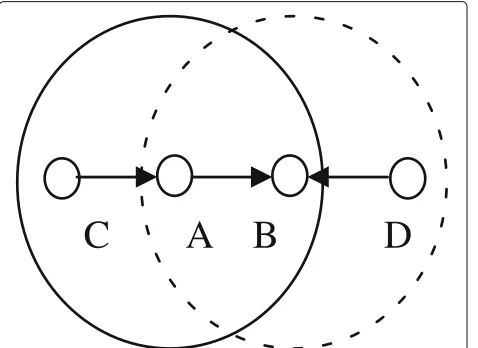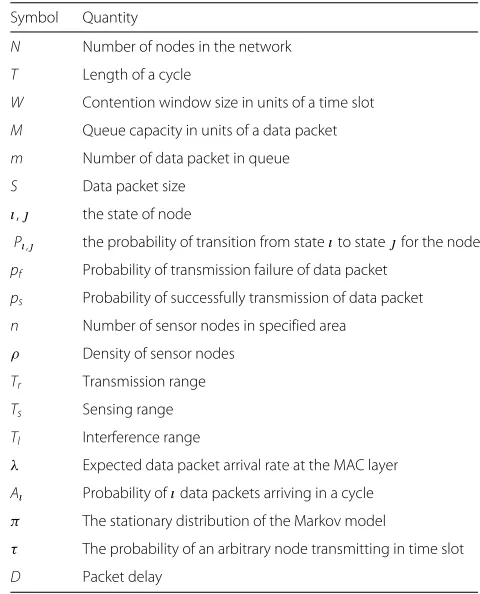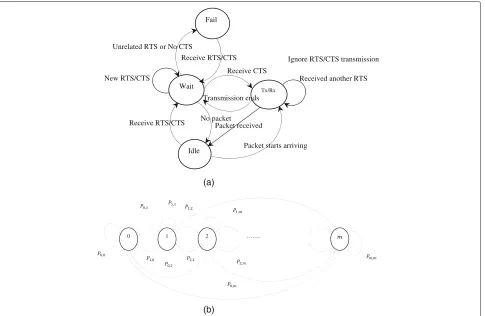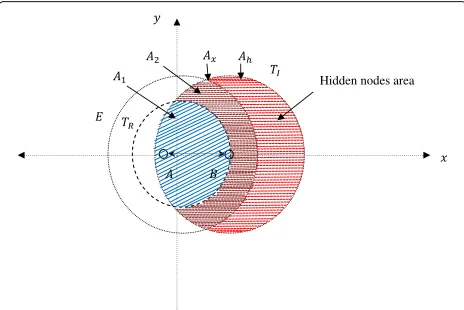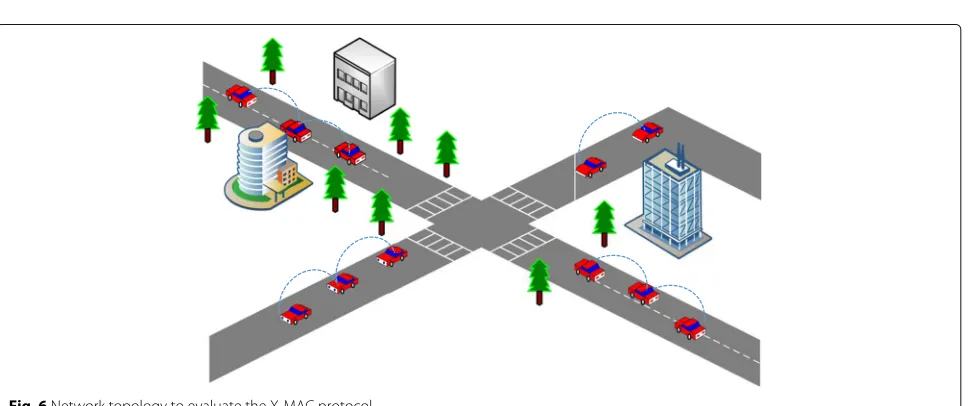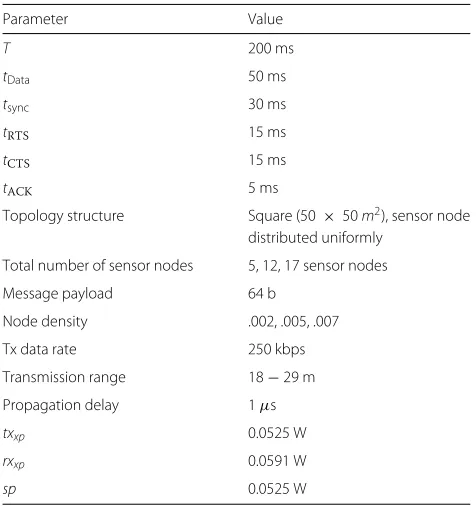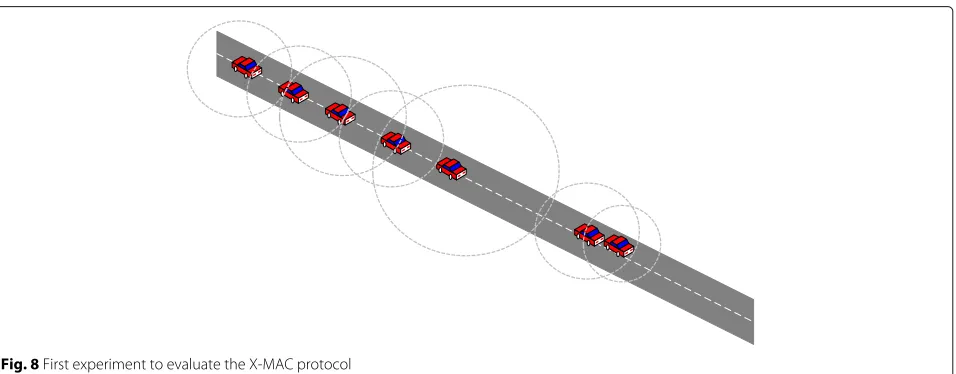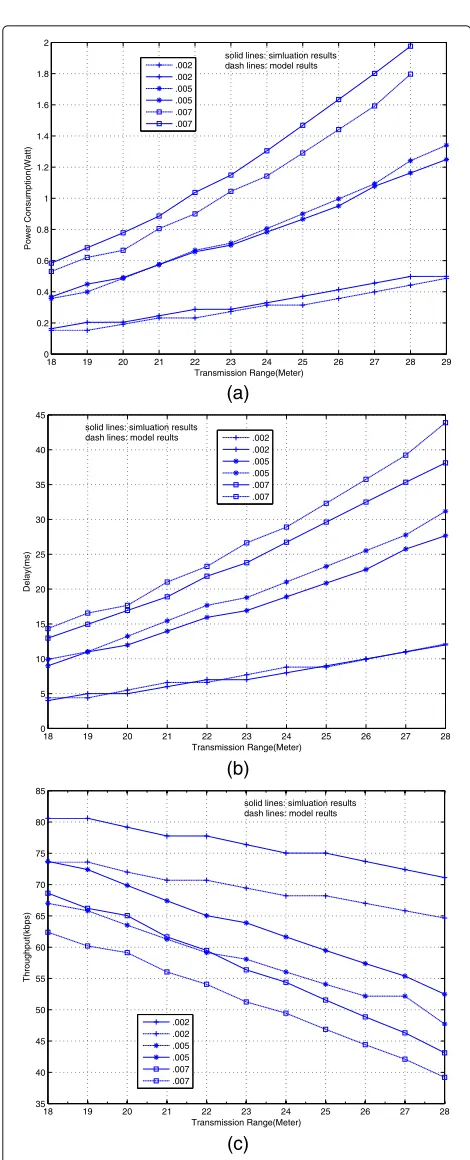R E S E A R C H
Open Access
Evaluation of a duty-cycled asynchronous
X-MAC protocol for vehicular sensor networks
Mohammed Zaki Hasan and Fadi Al-Turjman
*Abstract
An asynchronous medium access control (MAC) duty-cycled protocols have higher energy efficiency and lower packet latency than synchronized ones due to reduced idle listening. Moreover, they provide efficient utilization of energy supplied to mobile sensors. They are considered very important in MAC protocols due to the adverse effects of hidden terminals which causes energy consumption in sensor networks. Therefore, in this paper, the impact of hidden terminals on the performance of an asynchronous duty-cycled MAC protocol X-MAC for vehicle-base sensor is investigated via analysis and simulations. We propose a Markov model to analyze the quality-of-service (QoS) parameters in terms of energy consumption, delay, and throughput. Our analytical model provides QoS parameter values that closely match the simulation results under various network conditions. Our model is more
computationally efficient and provides accurate results quickly compared with simulations. More importantly, our model enables the designers to obtain a better understanding of the effects of different numbers of mobile sensor nodes and data arrival rates on the performance of an asynchronous MAC duty-cycled protocol.
Keywords: X-MAC, Markov model, Quality-of-service analysis
1 Introduction
Vehicular sensor networks (VSNs) allow limited range sensor devices to communicate with each other [1]. VSNs are promising solutions for specific cases of the Internet of things (IoTs), which allow the integration of differ-ent objects to communicate with each other in dynamic environments [2]. The current trends in VSNs allow dif-ferent deployment architectures for vehicular networks in highways, urban, and rural environments to support many applications with different QoS requirements [3]. Basically, VSNs came to allow the communication among nearby vehicles as well as fixed roadside equipments which leads to three different configures: vehicle-to-vehicle (V2V), vehicle-to-vehicle-to-infrastructure (V2I), and, hybrid networks’ architectures as illustrated in Fig. 1 [4]. Features of these configurations encounter new challenges in order to expand from being a network of computers to a network of both computers and things.
Devices in the IoT connect with each other using a vari-ety of protocols, and there still exist a large amount of
*Correspondence: fadi@metu.edu.tr
Department of Computer Engineering, Middle East Technical University, Northern Cyprus Campus 99738 Kalkanli, Güzelyurt, Mersin 10, Turkey
devices that use older communication protocols but have diverse real-time needs. Therefore, VSNs offers integrated communication protocols for effectively monitoring the physical world, especially in urban areas where a high concentration of vehicles equipped with onboard sensors is expected [5, 6]. Despite this, integration have benefits such as increasing revenue, reducing costs, and energy efficiency. However, there exists a serious problem with traffic congestion in decision making for vehicular traffic which is a challenge due to the particular characteristics, such as the highly dynamic topology and the intermit-tent connectivity [4]. Consequently, VSN has challenges in supporting the real-time traffic information that can significantly improve the safety of the transportation and can reduce the traffic congestion [7]. This information will help drivers to make smarter decisions in timely manner to prevent accidents, improve the efficiency of the selected route, and provide a safer distance among other vehicles. Therefore, the duty of the embedded sensor is to capture images and measure distance all around a vehicle in order to monitor traffic in an allocated area, while utilizing dif-ferent devices that can measure several physical traffic parameters [5]. Hence, the view of the vehicle as a sen-sor platform can improve the traffic flow, via supporting
B
A
C
Fig. 1Basic architecture of VSNs,avehicle-to-vehicle (V2V), bvehicle-to-infrastructure (V2I),chybrid
communication with the roadside infrastructure in order to provide ubiquitous coverage [8]. The relative velocities of vehicles are fairly much higher in than 50 km/h in urban environments and more than 100 km/h on the highway [4]. Vehicles also move at different directions. Thus, vehi-cles can quickly access or leave the network in a very short period of time. This results in more frequent changes in the network topology which affects the network design significantly. For example, the routing protocol design will be more difficult due to hidden/exposed terminal problem in MAC protocols [9]. Vehicles are typically not affected by strict energy constraints and can be easily equipped with sensor platforms [10]. Meanwhile, VSNs represent a significantly novel and challenging deployment scenario, which considerably differs from the traditional Wireless Sensor Network (WSN) and thus requires innovative solutions in the MAC layer [11]. However, designing an integrated architecture for both WSNs and VSNs often starts with the definition of a MAC protocol since it is a fundamental issue in determining the energy consump-tion properties and the basic data transport capabilities of the network [12].
This design of an efficient and effective sensory MAC protocol providing QoS requirements for real-time traffic management is considered as the most important step in end-to-end QoS provisioning over VSNs [13] since it reg-ulates nodes’ access to a shared channel and has become a major active research in recent years [14]. This regula-tion explicates as duty cycling approach that is considered as one of the primary mechanisms for providing QoS in VSNs [15].
Particularly, duty cycling means that every node in the network is periodically alternating between an awake and a sleep state [16]. Therefore, the duration of a duty cycle is equivalent to the time of an awake state plus the time of
sleep state [17]. Whereas the idle state has been founded in IEEE 802.11p standard for vehicular communication that consumes substantial energy to transmit up to 1000 messages with 32 dBm and therefore should be avoided in VSNs [4].
To understand the performance of VSNs and in order to optimize the designed routing protocol [18], an accu-rate analytical framework for MAC protocol is required. The main idea of this framework provides an analyti-cal scheme that dynamianalyti-cally adapt the vehicles’ rate of transmission according to their priority. The analytical model shall describe the effects of assigning various values including the density and transmission range of vehicle to protocol parameter under given specific scenarios in order to achieve the QoS requirements.
The remainder of the paper is organized as follows: section 2 discusses some related works devoted entirely to analytical modeling of MAC protocols. Section 3 introduces the synchronous X-MAC protocol, through overview of problem definition of hidden terminal and analyzing power consumption, delay, and network throughput. Section 4 introduces the behavior of X-MAC protocol under specific network conditions through using the proposed Markov model. Meanwhile section 5 intro-duces the performance analysis of synchronized X-MAC protocol. Furthermore, section 6 introduces detailed sim-ulation and analysis for the performance of a synchronized X-MAC protocol of various scenarios. Finally, section 7 concludes the current.
2 Related works
To better understand the mechanism of a MAC proto-col, it is useful to realize that MAC protocols consists usually of three main logical components [19]. First, a collision avoidance (CA) algorithm which uses physical carrier-sensing to register and/or reserve the channel for the duration of the data transmission. Second, a con-tention resolution algorithm which uses mechanisms such as back-off to regulate the access to the channel [19]. Third, distributed coordination function (DCF) which is not specifically designed for high mobility network [7].
sleeping state, while a sender with data packet to transmit waits in the listening state until the probing packets from the receiver is received. Therefore, receiver-initiated MAC protocol degrades the network performance with asym-metric links, due to several experienced sender failures in receiving the probing packets from the receiver. And hence, the asymmetric links waste energy, increase delay, and degrade the packet receive ratio (PRR). Meanwhile, RTS and CTS message exchange mechanism could not be the solution for VSNs since these exchange messages may not be able to arrive to all hidden nodes [20].
MAC protocols can be divided into two main categories of duty-cycled MAC protocols [17]. One is synchronized protocols, like S-MAC [21] and T-MAC [22]. The other is asynchronous protocols, like X-MAC [17] and B-MAC [23]. Asynchronous duty-cycled MAC protocols remove the energy overhead for synchronization and are easier to implement as they do not require local synchroniza-tion [24]. X-MAC protocol uses data packets as preambles and suits it for sparse networks as the energy and colli-sion increase linearly with the node density. And thus, the performance of X-MAC protocol is evaluated in this work when equipped with CA algorithm to address the perfor-mance degradation of wireless multihop communications with hidden terminals, and their impact on MAC proto-cols. Additionally, the X-MAC contention-based protocol does not perform well in asymmetric scenarios due to the quality of the link from the receiver to the sender which causes the hidden terminal problems and can be avoided if the communication was not receiver-initiated [25].
Many researchers evaluated the performance of vari-ous network protocols through simulations [26]. How-ever, the simulation environment/software is usually too expensive and/or time-consuming, especially while considering a huge network size/capacity [27]. Mean-while, the analytical models can be more effective in such cases, since the scale of modern networks and the degree of complexity often necessitate the use of simplified assumptions, e.g., Markov, Poisson traffic, or other models. Furthermore, it is hard to capture the dynamic nature of a network without an analytical model; therefore, an analytical model is needed to provide insight into the performance of both routing and MAC protocols [27].
Bianchi [28] proposed an accurate analytical model to analyze the performance of single-hop IEEE 802.11. Ziouva [28] improved Bianchi’s model by adding a deriv-ing saturation delay beside throughput. In an area other than IEEE 802.11 specifically in WSNs the author in [29] proposed a radio model to compute the lower bound of X-MAC protocol. A new hybrid MAC scheme called Zebra MAC (ZMAC) is proposed in [30] for sensor net-works which combine the strengths of TDMA and CSMA while offsetting their weaknesses. The authors in [31]
implements an efficient TDMA protocol that apply duty-cycling function for multihop WSNs using semi-Markov chain. Authors tries to avoid channel access problems such as over hearing and hidden terminal by adapting the wakeup/sleep state of each node to the actual operational conditions such as traffic demand and node density. Short range V2V communication was investigated in [32]. The authors present a study in which effective information such as the message size, transmission range, and veloc-ity of vehicles is exchanged. Such exchanged parameters are considered as factors in analytical model to evalu-ate the performance of communication. Meanwhile, the authors in [33] presents a study of connectivity in vehic-ular ad hoc network in traffic free-flow. Actually, the authors use the analytical model in describing the dis-tribution of distances between the vehicles, traffic flow on the highway to evaluate the effects of various sys-tem’s parameters (such as distribution of velocity, traffic flow, and transmission range of vehicles) the network on connectivity.
B-MAC [23] considers the default MAC protocol for Mica2 that allows an application to implement its own MAC through a well-defined interface. To achieve chan-nel utilization and low power operations, the authors adopt low power listening (LPL) and scheduling the clear channel sensing (CCA) technique to reduce duty cycle and to minimize idle listening. Yang in [34] modeled and analyzed the throughput of a synchronized duty-cycle S-MAC protocol for WSNs. S-MAC protocol has differ-ent rules for accessing the media as compared against other MAC protocols such as X-MAC or B-MAC. Yang also proposed a Markov model to analyze the through-put of X-MAC. It should be emphasized that our pro-posed model is fundamentally different from the one proposed by Yang [29]. Our proposed model analyzes the performance of X-MAC protocol when it is equipped with CA algorithm and aimed of addressing the per-formance degradation of VSNs with hidden terminal. However, none included the hidden terminal problem in their analytical models. The paper focuses on the evaluate of an adaptive energy-efficient X-MAC proto-col for duty-cycled VSNs. A Markov queuing model is proposed for modeling the behavior of the X-MAC con-tention based on the specific sleep/wake-up pattern in the duty cycle. Our proposed model quantifies the desir-able QoS metrics for contention-based MAC protocols in multihop fashion to address the hidden terminal prob-lem and to provide fairness in medium sharing among the vehicles.
3 Overview of X-MAC protocol
MAC protocols [29]. Many variations asynchronous duty-cycled MAC protocols have been proposed to improve energy efficiency and packet latency by allow-ing each node to independently and periodically sleep to save energy [35]. Additionally, asynchronous proto-cols use a series of short preamble packets to avoid synchronous overheads and hence have higher energy efficiency than synchronized MAC protocols [36]. These short preamble packets carry the address information of the sink node. As a results the intermediate nodes can go to sleep as soon as they hear the first short preamble. Moreover, the sink can reply with an ACK message in between two successive short preambles to stop the timeline and to start transfering the data packets [17].
Figure 2 indicates the timelines’ LPL of short preamble packets of X-MAC protocol that effectively constitutes a single long preamble [17]. Whereas a node wakes up peri-odically to send and receive a short preamble packet to sink node which is still sleeping, it looks at the ID of sink node included in the packet. If the other nodes are not the intended recipient, they go to sleep quickly to avoid the overhearing problem; otherwise, they remain awake for the subsequent packet. Hence, the interval between two successive wake-up periods called a cycle denoted asT for every node. Every node begins its duty with a fixed-cycle length determined with an arbitrary offset and
continues its duty cycling as if the medium had been idle. For each successfully delivered data packet, the average communication time isT2 pulsing the length of data packet
LDATA[29].
X-MAC also has collision related within increasing the network density, i.e., the number of senders increases, and they wake up and begin to send their preamble at the same time since. Thus, all nodes including sink-nodes cannot determine the destination address information in preamble when collision occurs among nodes. In this case, the sender continues sending preambles until next wake-up time [17]. Hence, for each colliding data packet, the average communication of sending data packet is alsoT.
This paper proposes a mathematical model for X-MAC protocol which to includes the effects of CA algorithm. Our proposed model focuses onto two main contributions which are: (1) solving the problem of medium contention such as hidden or exposed termi-nal problem, and (2) providing resource reservation for real-time traffic control system in a distributed vehicle-based sensor environment. Moreover, supporting QoS in the routing or transport layer cannot be provided unless the assumption of MAC protocols solves the problems of medium contention and supports reliable communication [37].
Our proposed model acts as analyzer for the perfor-mance of X-MAC since the Markov model is used to
Long preamble
Send DATA
Receive DATA Target address in data header
Listen for queued packets R wakes up
time time
Send DATA
Receive early ACK Short preambles with target
address information
Receive DATA
ACK
Send early ACK R wakes up
Time & energy saved at S & R
X-MAC Receiver (R)
X-MAC Sender (S)
LPL Receiver (R) LPL Sender (S)
Extended wait time
time
time
describe the behavior of accessing of synchronized duty-nodes to the channel. The proposed model elaborates on which type of low duty-cycled MAC protocols should be selected in order to resource the wireless channel reserva-tion that assures the desirable QoS level in real-time traffic control systems.
4 Markov model of X-MAC
We propose a Markov model to describe the behavior of X-MAC and investigate the QoS parameters under vari-ous network and channel conditions. However, to estimate the effect of the hidden problem, it is necessary to exam-ine the transmission among one-hop neighbor nodes at region where possible hidden problem occurs as depicted in Fig. 3 in which node A transmits a frame to node B, and node D transmits to node B. Thus, node D will be able to do it, as it is unable to detect the transmission of node A or node C. This means that both nodes C and D are hidden to each other resulting in a collision at node B that causes a serious QoS degradation especially in high-data-rate sensor applications [29, 38].
In order to satisfy the QoS requirements for real-time traffic control systems, a Markov discrete-time stochastic process M/M/1 queuing model is proposed under realistic conditions for duty cycling with schedule-driven oper-ation in VSNs. We consider a simple traffic model for vehicle moving along a straight road with random veloc-ity. The arrival and departure of the data packets are regulated under a realistic assumption of a finite queue size. Therefore, the proposed model makes the following assumptions:
1. Event arrivals denote a stochastic process
{A(t)|t≥0}that represents the total number of arrivals that have occurred from time 0 to timet; this procedure creates an independent Poisson process at
A
B
D
C
Fig. 3Hidden terminal problem in contention-based protocols
each node, and the number of packet arrivals in any time slot is distributed with a Poisson process with parameterλτ, for time of arrivaltτ ≥0.
2. Letπı(t)denote the steady state of power for the node at timet; the inter-arrivalδ≥0times (that is, the distribution of time at stateıbefore marking the transition) are independent and exponentially distributed with theλ, whereo(δ)is defined as a function ofδsuch thatlimδ−→0o(δ)δ .
3. The queueing discipline of data packets is first-come, first-served (FCFS).
4. The queueing system assumes equilibrium under the condition that the probability of arrival is less than the independent probability of transmitting the information packet orλ < β.
5. The processing and radio-transmission times are independent and identical(ı.ı.d.)with an arbitrary distribution.
6. Retransmission is supported.
7. When an event is sensed, the node processes it and sends the information packet with a probability of transmission per node per cycle, and every sensor node in the network has an independent probability of transmitting information packetβin the duty cycle.
These assumptions are made based on [39] which have been verified as valid approximations of realistic scenar-ios. The proposed Markov model shows that the power transition of each sensor node in the network may be modeled by a discrete-time M/M/1 Markov chain, which represents a different predefined status for a node for an event at the wake-up/sleep mode of the duty cycle. The proposed model considers the following assumptions:
(a) The vehicles are equipped with sensor nodes in a network and are assumed to be two-dimensionally Poisson distributed over a domain with density ρ. Therefore, the probability of findingnneighboring nodes in an areaSis given by [34].
p(n,S)= (ρS)
n
n! exp
(−ρS). (1)
(b) If each node has the same transmission range TR for transmission and receiving in time-slotted mode, then the number of n neighbors within a circular region ofTRis given as [40].
n=ρπTR. (2)
(c) All nodes are assumed to be saturated, i.e., they always have some data packet in queue waiting for transmission, and all the data packets have the same length.
RTS, CTS, DATA, and ACK), processing delay, car-rier sense delay and queuing delay.
(e) Each sensor node has transmission rangeTRdefined as [38]
TR= β
GtGtλ2Ptx
αSen , (3)
TS is sensing range, and the interference range is defined asTI=TR√βTRCP, whereTRCPandSenare defined threshold of capture ratio, and the receive sensitivity in Watt, respectively [38].
(f) The propagation model is defined as
Ptx=Sen
GtGtγ2
(4π)2dβ
, (4)
and
Prx=
Ptx
αdβ, (5)
whereddefined the distance between two transmis-sion nodes. This model cover with free-space model is defined by
α= (4π)2
ω2G tGt
, (6)
where both Gt and Gr are defined by the antenna gain, γ is the wavelength, and β is defined by the path-loss exponent [38].
Table 1 lists all assumption that are used throughout the paper.
A node may exchange its status slot by slot, which cor-responds to the transition from one state to another in the Markov chain as depicted in Fig. 4a. Figure 4b shows that the proposed Markov model has limited queuing capacity denoted asMwith finite state slots from left to right, which corresponds to 0 state for processing pack-ets in the queue and so on to m packets in the queue (full queue). Specifically, if a packet arrives and the queue is full, then the packet is simply dropped; nevertheless, the packets are removed from the queue when they are successfully transmitted. By contrast, when the queue is neither full nor empty, then a node may obtain access to the media to transmit packets with an independent prob-ability. The analysis of the Markov discrete-time M/M/1 queuing model offers insights into the traffic behavior of vehicle-based sensor networks in general and points to an idea for a control algorithm.
The steady state probability and the transition probabil-ities of moving from one state to another can be described as follows:
P0,ı =λıδ, ı =0,. . .,M, (7a) P0,ı =Aı,ı=0,. . .,M, (7b)
Table 1Assumptions
Symbol Quantity
N Number of nodes in the network
T Length of a cycle
W Contention window size in units of a time slot
M Queue capacity in units of a data packet
m Number of data packet in queue
S Data packet size ı,j the state of node
Pı,j the probability of transition from stateıto statejfor the node
pf Probability of transmission failure of data packet
ps Probability of successfully transmission of data packet
n Number of sensor nodes in specified area ρ Density of sensor nodes
Tr Transmission range
Ts Sensing range
TI Interference range
λ Expected data packet arrival rate at the MAC layer
Aı Probability ofıdata packets arriving in a cycle π The stationary distribution of the Markov model
τ The probability of an arbitrary node transmitting in time slot
D Packet delay
P0,M=A≥M, (7c)
Pı,ı−1=psA0,ı=0,. . .,M. (7d)
Pı,ı−1=psAj−ı+1+(1−ps)Aj−ı,ı =1,. . .,M−1. (7e)
Pı,M=psA≥M−ı+1+(1−ps)A≥M−ı, ı=1,. . .,M. (7f)
Wait
Idle
Tx/Rx Fail
New RTS/CTS
Receive RTS/CTS
Packet received No packet Receive RTS/CTS
Packet starts arriving Unrelated RTS or No CTS
Receive CTS
Transmission ends
Ignore RTS/CTS transmission
Received another RTS
(a)
0 1 2 ……..
(b)
Fig. 4Markov model for the X-MAC protocol and node.aMarkov chain model for a node, (b) Markov chain model for X-MAC
the schedule-driven duty-cycle node operation, including the processing and transmission of information packets.
Equations 7d and 7e also describe the non-transition probability state (i.e., the probability of having a non-decreasing queue), which can be obtained from two terms depending on the oldest information packets still in the queue and winning the contention to access the media (first term) or otherwise (second term) [35, 38].
4.1 The hidden problem formulation
According to the heavy-traffic assumption [41], each node in the network always has a packet in its buffer to be sent. Suppose a node is ready to transmit with proba-bilityps, the probability of collision ispf,Aı defines the probability thatı of data packet arrives at node during a cycle, andA≥ı is the probability that no less thanı data packets arrive at a node during a cycle. Then,psis con-sidered as a protocol-specific parameter that is slot inde-pendent. This means that the probability of transmission and the collision varies from another time slot, depending on the behavior of both duty-cycled node which mod-eled as Markov-chain and the state of channel which is depicted in Fig. 4, where π0 indicate the steady state of a node. Because of a node may transmit or not in the
slot depending to the mechanism that is used to avoid and resolve the collision as well as the current state of the channel [39]. Therefore, there is an exact relationship between ps and pf and should be derive to investigate the effects of ps and pf on performance of multihop network.
Generally, for single-hop IEEE 802.11, Bianchi [28] has proposed a multi-dimensional Markov chain-model to derive the probability of successful packet transmission as a node always has a packet in its buffer ready to send and that the next hop is randomly selected as
ps(pf)=
2
1+W+pfW( 2pf)m−1
2pf−1
(8)
where W is the minimum contention window size and
mis the retry limit. Suppose that the sensor node is in a steady state, then the probability of an arbitrary sensor node transmitting in time slot denoted byτis [42].
τ = psT
D , (9)
whereλdefines the average event inter arrival rate,Ttranis the transmission time, andY defines the processing time per event.
In general ,τ depends on the conditional transmission probability ps and collision probabilitypf, which is still unknown as shown in Eq. 3. Therefore, to find the value
τ, it should be first assumed successfully received value as the probability that only one node of then neighboring nodes is transmitting [43]. Because each nodentransmits with probabilityτ, therefore,
ps=nτ(1−τ)(n−1) (11)
Moreover, to find the value ofpf in a time slot at least one
nstill transmit this yields as [44]
pf =1−(1−τ)n−1 (12)
Equations 5 and 6 represent a nonlinear system in the two unknowns τ and ps that solved using Gregory-Newton Forward Difference Approach [45].
Consequently, it can use a similar approach to build the Markov chain model for duty-cycle MAC protocol of a saturated node to obtain the relationship between ps and pf because of low duty-cycle MAC protocols used the same factors like IEEE802.11 protocols to quantify the QoS parameters. Expect that there is extra delay in low duty-cycle MAC protocol which is caused by the sleep period of each node [46].
4.2 Media access rules of X-MAC
The hidden problem considers the first MAC problem that should be solved to investigate the network perfor-mance and to provide resource reservation and fulfill QoS requirements. Suppose that the transmission in sensor networks begins from node A that transmits data pack-ets to node B as depicted in Fig. 5. Then, the propagation model between nodes A and B is given as
Hidden nodes area
Fig. 5Transmission, reception, and interference ranges
Prx(B)=
Ptx(A)
αd(A,B)β. (13)
Therefore, the set of sensor nodes that are able to detect the transmission of node A is denoted as Ntx(A) and defined as
Ntx(A)= {x|d(x,A)≤R}, (14) whereRis the transmission range defined as
R= β
Ptx(A)
αTR
(15)
where the sensor nodes are distributed inside the dot-ted circle, the set of nodesNrxthat is distributed outside E transmission range is defined as E = β
Ptx(A) αSen can-not detect the transmission of node A [38]. This set is delimited by the shaded area and is calculated using the geometry equations as [1].
AH(TR)=πTI2−2TI2
Assume thatAx(TR)be the common shaded area that illustrates the locations at which possible hidden termi-nals reside. These circles of radius ofE andTI intersect at two pointsu,−√E2−u2andu,√E2−u2where value of the hidden nodes are calculated as [47]
Ah(TR)=πIR2−Ax(TR), (20)
The axioms of probability used to estimate the collision probability are performed by evaluating the dimensions of probabilistic of combination of events that might occur withinAxandAhareas. Therefore, the derivation of col-lision probability depends on two rules: the addition rule which deals with the probability of union of more events; and the multiplication rule which deals with the probabil-ity of intersection of two events.
Suppose thatExbe an event which collision occurs by one or more nodes withinAx area, andEh be an event which collision occurs by one or more nodes withinAh area. Then, the collision probabilitypf is calculated as [1]
pf =pEx+pEh−pExpEh, (21)
wherepExis the probability of the eventExwhich is given as [1] define as the probability of the event Eh that can be obtained as in [1] by
pEh=Pr{only one awake sensor node withinAx}
5 QoS parameter analysis of X-MAC protocol
QoS parameters expressed in terms of energy consump-tion, delay, and throughput can be calculated within a cycle time, since X-MAC works in duty-cycled fashion. Therefore, an active period of a wake-up node is defined in cycle time asTawaketime units. During this active period, the preamble packets data packet has sizeS, and an ACK message are assumed asTpre,TData, and TACK time slot units to transmit, hence, Markov model has a unique stationary distributionπ =π0,. . .,πM[29].
Usually, X-MAC uses a fixed-preamble size carrying the address of the sink to transmit the data packet. Suppose that a sensor network is fully connected with n nodes, and then each node wakes up periodically for successful transmission of a data packet with probability(1−π0)ps which takes time on average T2 +TData. Each node uses
T
2 periodically to send preamble packets and then a node
starts to listen to the ACK messages between two succes-sive preamble packets, whereasTDatais used periodically to successfully transmit a data packet with specific prob-ability. Hence, the average time it takes to send preamble packets isT2 Tpre
Tpre+TACK
. The average time a node takes to
listen to the media is T2
TACK Tpre+TACK
. Finally, the amount of energy that is consumed in this case is calculated as [18]
Energy1=(1−π0)psτ
In similar case, a node wakes up periodically to unsuc-cessful transmission of a data packet with probability
(1−π0)pf that implies other node synchronizes to send preamble packets. However, in this case, there is no preamble packets that may be received correctly because of collision, and then the node continues sending pream-ble packets with average time T
T
pre Tpre+TACK
, and the average time of listen to media between two successive preambles isT
TACK Tpre+TACK
. The amount of energy con-sumed in this case is [18]
Energy2=
Suppose that the node has received complete preamble packets, then it sends backTACK message to receive the data packet. However, any intermediate nodes may wake up to send a preamble packet or listen to receiveTACK message from the sink. As a result, the time on average of the receiving node isTpre+2TACK. Therefore, the amount of energy consumed is
2+Tpre because it cannot detect the collision until it hears the next colliding preamble packets. Hence, the amount of energy consumed is
Totally, the energy consumption per hop per second can be obtained as
Energy= 4
i=1
Eı (28)
The analysis of the delay of data packet depends on the probability of successful transmission ps for each node that wins the contention and the steady state of the Markov model π0 during the cycle. Therefore, a node starts to send contends for the media during the cycle until win the contention with probabilitypsand the probabil-ity 1−psto lose the contention. Hence, the delay is given along cycle lengthT.
Delay=T ∞
ı=1
(ı+1)ps(1−ps)ı (29) The derivation of the probability of successful transmis-sion and collitransmis-sion in X-MAC protocol depends on the sta-tus of the queue and the channel. This means that a node have empty/empty queue according to the steady state free/busy of the proposed Markov chain model. Further, the status of channel is free/busy according to detection of collision occurring by event. Suppose that A defines an event that occurs by one or more two node winners in the contention within the areaAx. And B is defined as an event that occurs by two or multiple node winners in the contention with areaAh. Then [9],
ps=Pr(A, free|empty)=Pr(A|free, empty)Pr(free|empty) (30)
pf =Pr(B, free|empty)=Pr(B|free, empty)Pr(free|empty) (31)
To solve for Pr(A, free|empty) and Pr(B, free|empty), assume that a node has an empty queue and directly wakes up and detects the event and transmit a data packet for its
neighbors. At the same time, other nodes wake up but do not have any data packet for transmission. Therefore,
Pr(A|free, empty)= T
t=1
1 T
N
c−1
ı=1
Nc−1
i 1 T
ı πi
0
T−1 T
Nc−1−ı
(32)
Similarly, when one other node wakes up and has data packet for transmission then a collision occurs, therefore, the collision probability is
Pr(B|free, empty)= T
t=1 1 T
⎛ ⎝Nc−1
ı=1
Nc−1
ı
1 T
ı
⎛ ⎝ı
j=1
(1−π0)jπ0ı−j
T−1 T
Nc−1−ı
⎞ ⎠ ⎞ ⎠
(33)
Pr(free|empty)is defined as the probability of a free chan-nel when a node wakes up and has data packet in its queue ready for transmission. As mentioned, each node in X-MAC protocol periodically wakes up and sends preamble packets and then a node starts to listen to channel; the channel have the same probability of being free or busy in every time slot [18]. Hence, when a node wakes up, no matter whether its queue is empty or not, the node sees the channel with the same probability of being free or busy. Therefore,
Pr(free)≈Pr(free|empty) (34)
Table 2Experiment parameters for X-MAC protocol
Topology structure Square (50× 50m2), sensor node distributed uniformly
Total number of sensor nodes 5, 12, 17 sensor nodes
Message payload 64 b
Node density .002, .005, .007
Tx data rate 250 kbps
Transmission range 18−29 m
Propagation delay 1μs
txxp 0.0525 W
rxxp 0.0591 W
sp 0.0525 W
The probability of free channel is determined by two parameters: (a) the average length of the free channel; and (b) the average length of the busy channel. Therefore, the probability of free channel is expressed as
Pr(free)=
Cfree
Cfree+Cbusy
(35)
To calculateCfree, assume that the interval of time trans-mission ends, and the free channel begins, there are num-ber of cyclescyclethat could define the free channel until some nodes begin to transmit attthslot. Thus, the average length of free channel iscycleT+t, and the probability of transmission event is [18]
Pfree(cycle,t)=πNccycleNc−1
Therefore, the average length of free channel can be obtained as [18] solid lines: simluation results
dash lines: model reults
(a) solid lines: simluation results
dash lines: model reults
(b) solid lines: simluation results
dash lines: model reults
(c)
Fig. 7X-MAC performance with varying cycle length.aPower consumption, (b) Delay, (c) Throughput
Therefore, both successful transmission and collision are calculated as [18]
Psuc(cycle,t)=π0NcıN=c−01
Nc−ı j=1
Nc
ı
t T
ı πı
0
Nc−ı
j
1
T j
j
1 (1−π0)π j−1
T−t−1
T
Nc−ı−ı
(38) Pcol(cycle,t)=πNc
0 Nc−2
ı=0 Nc−ı j=2 jk=2
Nc ı
t T
ı
πı
0
Nc−ı j
j
k
j
(1−π0)kπ0j−k
T−t−1 T
Nc−ı−j
(39)
The average length of a busy channel can be calcu-lated according to the successful transmission data packet which takes on average timeT2 +TData+Psuc. Therefore,
Cbusy =
∞
cycle=0 T−1
t=0
T
2 +TData Psuc(cycle,t)+TPbusy(cycle,t) (40)
Substituting Eqs. 38 and 35 into 33, then Pr(free) is obtained. Plugging 30 and 32 into 28, and then plugging 31 and 32 into 29, the successful transmission probability for each nodepsthe probability of collisionpf are obtained. Therefore, the throughput per second per hop of X-MAC protocol can be calculated as
Throughput=Nc(1−π0)ps
S
(Tτ) (41)
6 Simulation results
Consider that a vehicle is equipped with wireless devices; therefore, they can communicate with each other. How-ever, the primary application is to let vehicles exchange about their current context in order to detect abnormal events in an urban environment. The network topol-ogy is shown in Fig. 6; our proposed model provides detailed analysis for the performance of a synchronized X-MAC protocol under the impact of the hidden prob-lem as well as under unicast traffic for various network configuration, conditions, and other assumptions for spe-cific scenarios. The analytical correctness of the pro-posed model was validated through implementation using MATLAB [48].
In all the simulations to be presented in the paper, the network set-up is a fully connected with varying num-ber of connected nodes, i.e., vehicles. The transmission range of each vehicle is 18 m, and the cycle length of time period is 50 s. For each set of simulation, energy consump-tion, delay, and throughput are investigated under varying network parameters of the vehicle. The values of the net-work parameters used are summarized in Table 2. These parameters are set to comply with the X-MAC protocol specifications. All vehicles are distributed rating using a two-dimensional Poisson distribution within an area of 50 × 50m2.
Figure 7 shows the performance of X-MAC protocol for multihop communication fashion under varying cycle lengthT from 50 to 200 ms as shown in Fig. 8. Figure 9 shows the performance of X-MAC protocol under varying vehicle densities in the network and transmission range of each vehicle varying from 18 to 29 m as shown in Fig. 10. From these results, it can be seen that the analyt-ical results of the proposed model match the simulation results.
18 19 20 21 22 23 24 25 26 27 28 29
solid lines: simluation results dash lines: model reults
(a) solid lines: simluation results
dash lines: model reults
(b)
solid lines: simluation results dash lines: model reults
(c)
Fig. 9X-MAC performance with varying transmission range.aPower consumption, (b) Delay, (c) Throughput
6.1 Varying the cycle length
In this experiment, we vary the cycle length, Fig. 7a shows the power consumption of the X-MAC protocol obtained
from simulations and from our power consumption anal-ysis using the Markov model. Our analytical results match the simulation results with percentage difference or max difference in power consumption. The power consump-tion decreases as the length of cycle period increases which means that whenever the cycle length increases, the unsuccessful data transmission increases due to increase in the rate of collision probability. Consequently, as the cycle length increases and as the number of vehicles increases, the power consumed in data transmission increases, and the active period in each cycle is fixed. Therefore, all vehicles in the network expect the source vehicle and the sink node in either successful transmission or unsuccessful transmission to go to the sleep state as long as the cycle length increases. Thus, the power saving in this longer sleep period is more than in longer transmis-sion period, the power consumption of X-MAC protocol decreases as the cycle length increases.
Figure 7b shows that the average delay of the X-MAC protocol increases as the length of cycle period increases. Usually, before the X-MAC protocol saturates and the cycle length starts from small value with a few vehicles in the network. X-MAC protocol can deliver all the incoming data packets as soon as they arrive in the network, hence, the delay is nearly zero. Once X-MAC protocol saturates and the cycle length increases, both the contention and queue delay increases proportional to the increases of the cycle length and the number of nodes. Since the X-MAC protocol can no longer deliver all the incoming data pack-ets, the queue at each vehicle overflows and data packets are dropped.
Figure 7c reveals that the average throughput of the X-MAC protocol decreases as the cycle length increases and as the number of vehicles in the network increases. This means that before X-MAC saturates, the amount of incoming data packet delivered remains in the queue and slightly decreases when X-MAC protocol saturates and as the number of vehicles in network increases further. As the X-MAC protocol can no longer deliver all the incom-ing data packets because of the increasincom-ing collisions at the following specified period.
6.2 Varying the number of nodes
Fig. 10Second experiment to evaluate the X-MAC protocol
is fixed. Therefore, all vehicles in the network expect the main vehicle source and the main sink node in either successful transmission or unsuccessful transmis-sion wake-up as longer as the cycle length increases. Thus, power savings in this longer sleep period became more than in longer transmission period, the power consump-tion of X-MAC protocol decreases as the cycle length increases.
Figure 9b shows the delay of the X-MAC protocol. Before X-MAC saturates, the delay slowly increases with lower node density and with fewer variation in the trans-mission range vehicle in cycle. Moreover, as the number of vehicles increases, a vehicle tends to have a higher probability of successful transmission leading to satura-tion state. Therefore, the delay dramatically increases as X-MAC saturates because of the increases in the rate of collision probability in a cycle. This means that the more vehicles in the network leads to decreasing the probabil-ity of successful transmission of packets when X-MAC saturates. Hence, according to the main parts of X-MAC protocol data packets delay (the queue delay and con-tention delay) this increase is obvious when the number of vehicles and the transmission range increase.
Figure 9c shows the throughput of X-MAC proto-col. Before X-MAC saturates, the amount of incom-ing data packet in cycle remains, the node can deliver all incoming data packets in cycle. Once the transmis-sion range of vehicle in a cycle increases, the through-put decreases as well as the vehicle density increases. This means that X-MAC can no longer deliver all incoming data packets, because of increasing the trans-mission range leading a vehicle tends to have higher probability of successful packet transmission leading to saturation state. Therefore, the throughput shrinks dramatically because of the increase in the probability of collision.
6.3 Discussion
RTS/CTS, exchanged messages may have to pass through several relay nodes before being delivered to all others nodes. However, MAC protocols might need to exploit asymmetric links to solve the hidden terminal problem while maintaining the lowest cost. In fact the network utilization and cost are weights derived and constrained by the network resource management (NRM) approach, where some routing or MAC protocols based on QoS parameters such as (power consumption, throughput, and latency) are application-dependent and imposed by the node specification. Therefore, to optimize these parame-ters in order to achieve the desirable benefits and network performance, the NRM approach shall be chosen based on the desire QoS parameters. As a result, the inclusion of asymmetric links in the MAC protocol design can further improve the network performance.
7 Conclusions
In this paper, the QoS parameters of X-MAC are mod-eled and analyzed using Markov chain model. Our model presents analytical results which have been validated by simulation results for the selected QoS parameters under various network conditions and traffic loads. It provides sufficient information about the links between the vehi-cles to determine the optimal path and to select the intermediate nodes for packet routing from source to dis-tention. Our future work will focus on analyzing the QoS parameters for synchronized protocols and extending the model to multihop networks.
Acknowledgements
The authors extend their appreciation to the anonymous reviewers for their helpful and supportive comments towards improving our paper.
Funding
The authors declare that they depend on their own personal fund in order to publish this article.
Authors’ contributions
MZH and FA-T conceived the idea and wrote the paper. MZH performed the experiments and analyzed the data. FA-T gave valuable suggestions on the motivation of this work and assisted in revising and proofreading the paper. Both authors read and approved the final manuscript.
Competing interests
Both authors declare that they have no competing interests.
Publisher’s Note
Springer Nature remains neutral with regard to jurisdictional claims in published maps and institutional affiliations.
Received: 21 September 2016 Accepted: 9 May 2017
References
1. F Al-Turjman, H Hassanein, M Ibnkahla, Quantifying connectivity in wireless sensor networks with grid-based deployments. Elsevier: J. Netw. Comput. Appl.36(1), 368–377 (2013)
2. F Al-Turjman, Information-centric sensor networks for cognitive IoT: an overview. Ann. Telecommun.72(1), 3–18 (2017)
3. GT Singh, FM Al-Turjman, Learning data delivery paths in QoI-aware information-centric sensor networks. IEEE Internet Things J.3(4), 572–580 (2016)
4. F Cunha, et al, Data communication in VANETs. Ad Hoc Netw.44(C), 90–103 (2016)
5. K Nellore, GP Hancke, A survey on urban traffic management system using wireless sensor networks. Sensors.16(2), 157 (2016)
6. F Al-Turjman, M Gunay, CAR Approach for the internet of things. Can. J. Electr. Comput. Eng.39(1), 11–18 (2016)
7. W Xiang, et al, Wireless access in vehicular environments. EURASIP J. Wirel. Commun. Netw.2009(1), 1–2 (2009)
8. GP Hancke, GP Hancke Jr, The role of advanced sensing in smart cities. Sensors.13(1), 393–425 (2012)
9. T Asha, N Muniraj, Energy efficient topology control approach for mobile ad hoc network. Int. J. Comput. Sci. Issues (IJCSI).10(4), 289 (2013) 10. U Lee, M Gerla, A survey of urban vehicular sensing platforms. Comput.
Netw.54(4), 527–544 (2010)
11. U Lee, et al, Dissemination and harvesting of urban data using vehicular sensing platforms. IEEE Trans. Veh. Technol.58(2), 882–901 (2009) 12. P Suriyachai, U Roedig, A Scott, A survey of MAC protocols for
mission-critical applications in wireless sensor networks. IEEE Commun. Surv. Tutor.14, 240–264 (2012)
13. N Saxena, A Roy, J Shin, Dynamic duty cycle and adaptive contention window based QoS-MAC protocol for wireless multimedia sensor networks. Comput. Netw.52, 2532–2542 (2008)
14. P Mohapatra,AD HOC NETWORKS: technologies and protocols. (Springer Science & Business Media, 2005)
15. MZ Hasan, H Al-Rizzo, F Al-Turjman, A survey on multipath routing protocols for QoS assurances in real-time multimedia wireless sensor networks. IEEE Commun. Surv. Tutor (2017).
doi:10.1109/COMST.2017.2661201
16. P Park, et al, Duty-cycle optimization for IEEE 802.15.4 wireless sensor networks. ACM Trans. Sensor Netw. (TOSN).10(1), 12 (2013)
17. M Buettner, GV Yee, E Anderson, R Han, inpresented at the Proceedings of the 4th international conference on Embedded networked sensor systems. X-MAC: a short preamble MAC protocol for duty-cycled wireless sensor networks, (Boulder, Colorado, USA, 2006), pp. 307–320
18. Y Ou, W Heinzelman, Modeling and performance analysis for duty-cycled MAC protocols with applications to S-MAC and X-MAC. IEEE Trans. Mob. Comput.11(6), 905–921 (2012)
19. A Iyer, C Rosenberg, Understanding the key performance issues with MAC protocols for multihop wireless networks. Wirel. Commun. Mob. Comput. 6, 745–760 (2006)
20. G Wang, et al, A MAC layer protocol for wireless networks with asymmetric links. Ad Hoc Netw.6(3), 424–440 (2008)
21. Y Wei, J Heidemann, D Estrin, inProc. of the IEEE Int. Conf. on Computer and Communications Societies INFOCOM ’02. An energy-efficient MAC protocol for wireless sensor networks, (New York, 2002), pp. 1567–1576
22. KL Dam, inproceedings of the 1st Int. Conf. on embedded networked sensor systems. An adaptive energy-efficient MAC protocol for wireless sensor networks, (Los Angeles, 2003), pp. 171–180
23. J Polastre, J Hill, D Culler, inProc.SenSys’04. Versatile low power media access for wireless sensor networks, (2004), pp. 95–107
24. F Al-Turjman, H Hassanein, M Ibnkahla, inProc. of the IEEE Local Computer Networks (LCN). Quantifying Connectivity of Grid-based Wireless Sensor Networks under Practical Errors, (Denver, 2010), pp. 224–227 25. A Razaque, KM Elleithy, Energy-efficient boarder node medium access
control protocol for wireless sensor networks. Sensors.14, 5074–5117 (2014)
26. S Oteafy, F Al-Turjman, H Hassanein, inProc. of the IEEE International
Global Communications Conf. (GLOBECOM). Pruned Adaptive Routing in
the Heterogeneous Internet of Things, (Anaheim, 2012), pp. 232–237 27. H Wu, RM Fujimoto, G Riley, inProceedings of the winter conference in
simulation. Experiences parallelizing a commercial network simulator, (Arlington, 2001), pp. 1353–1360
28. G Bianchi, Performance analysis of the IEEE 802.11 distributed coordination function. IEEE J. Sel. Areas Commun.18, 535–547 (2000)
29. Y Ou, WB Heinzelman, inGlobal Telecommunications Conference
(GLOBECOM 2010), 2010. Modeling and throughput analysis for X-MAC
30. I Rhee, A Warrier, M Aia, J Min, ML Sichitiu, Z-MAC: a hybrid MAC for wireless sensor networks. IEEE/ACM Trans. Netw. (TON).16, 511–524 (2008)
31. MZ Hasan, F Al-Turjman, H Al-Rizzo, inInternational wireless
communications and mobile computing conference (IWCMC). Evaluation of
a duty-cycled protocol for TDMA-based Wireless Sensor Networks, (2016), pp. 964–969
32. G Yan, DB Rawat, Vehicle-to-vehicle connectivity analysis for vehicular ad-hoc networks. Ad Hoc Netw.58(1), 25–35 (2017)
33. F Al-Turjman, in2016 IEEE 41st Conference on local computer networks (LCN). Hybrid Approach for Mobile Couriers Election in Smart-Cities, (Paris, 2016), pp. 507–510
34. O Yang, W Heinzelman, in5th International Conference on Intelligent Sensors, Sensor Networks and Information Processing (ISSNIP). Modeling and throughput analysis for SMAC with a finite queue capacity, (Melbourne, 2009), pp. 409–414
35. MR Ahmad, E Dutkiewicz, X Huang, inEmerging communications for wireless sensor networks. InTech. A survey of low duty cycle MAC protocols in wireless sensor networks, (2011), pp. 69–90. https://www.intechopen. com/books/emerging-communications-for-wirelesssensor-networks/a-survey-of-low-duty-cycle-mac-protocols-in-wireless-sensor-networks 36. P Suriyachai, U Roedig, A Scott, A Survey of MAC Protocols for
Mission-Critical Applications in Wireless Sensor Networks. IEEE Commun. Surv. Tutor.14(2), 240–264 (2012)
37. MA Yigitel, OD Incel, C Ersoy, QoS-aware MAC protocols for wireless sensor networks: a survey. Comput. Netw.55, 1982–2004 (2011) 38. A Bachir, D Barthel, M Heusse, A Duda, inInternational conference on in
wireless networks, Communications and Mobile Computing. Hidden nodes
avoidance in wireless sensor networks, (Maui, 2005), pp. 612–617 39. J Garcia-Luna-Aceves, Y Wang, inAd Hoc Networks. Collision avoidance
protocols in ad hoc networks (Springer, 2005), pp. 23–61. https://link. springer.com/chapter/10.1007%2F0-387-22690-7_2
40. F Al-Turjman, H Hassanein, M Ibnkahla, inProc. of the IEEE Queen’s Biennial Symposium on Communications (QBSC). Quantifying the Effects of Placement Errors on WSN Connectivity in Grid-based Deployments, (Kingston, 2010), pp. 59–62
41. A Redondi, et al, Compress-then-Analyze vs Analyze-then-compress: what is best in visual sensor networks? IEEE Trans.Mob. Comput.PP(99), 1–1 (2016)
42. F Al-Turjman, H Hassanein, M Ibnkahla, Towards prolonged lifetime for deployed WSNs in outdoor environment monitoring. Elsevier Ad Hoc Netw. J.24(A), 172–185 (2015)
43. Y Kim, C Yang, C-H Liu, inIEEE GLOBECOM in Global telecommunications conference. Throughput analysis of randomized sleep scheduling with constrained connectivity in wireless sensor networks (IEEE, 2008), pp. 1–6 44. D Rodenas-Herraiz, A-J Garcia-Sanchez, F Garcia-Sanchez, J Garcia-Haro,
On the improvement of wireless mesh sensor network performance under hidden terminal problems. Futur. Gener. Comput. Syst.45, 95–113 (2015)
45. Z Chu, HX Nguyen, TA Le, M Karamanoglu, et al., inProc. of teh Int. Conf. on
Wireless Days. Game theory based secure wireless powered D2D
communications with cooperative jamming, (Portugal, 2017), pp. 95–98 46. MZ Hasan, F Al-Turjman, H Al-Rizzo, Optimized Multi-Constrained
Quality-of-Service Multipath Routing Approach for Multimedia Sensor Networks. IEEE Sensors J.17(7), 2298–2309 (2017)
47. TE Salti, D Stacy, et al., inProc. of the International Wireless Communications and Mobile Computing Conference. Packet delivery significance and metrics improvements in protocols for 3-D routing in Wireless Sensor Networks, (Nicosia, 2014), pp. 1130–1135
48. G Singh, F Al-Turjman, inProc. of the International Wireless
Communications and Mobile Computing Conference (IWCMC). Cognitive
Routing for Information-Centric Sensor Networks in Smart Cities, (Nicosia, 2014), pp. 1124–1129
49. E Ziouva, T Antonakopoulos, CSMA/CA performance under high traffic conditions: throughput and delay analysis. Comput. Commun.25, 313–321 (2002)
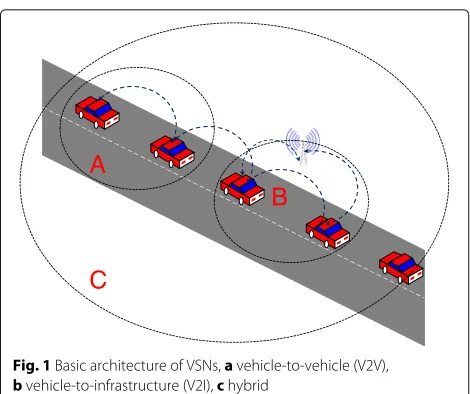
![Fig. 2 The timelines LPL and X-MAC protocol for the short preamble approach [13]](https://thumb-us.123doks.com/thumbv2/123dok_us/929917.1112903/4.595.59.540.439.716/fig-timelines-lpl-mac-protocol-short-preamble-approach.webp)
